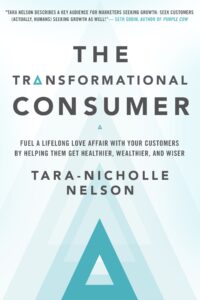The Transformational Consumer
It’s time to rethink what you sell. And your customers. Don’t forget to rethink your marketing, your competition. And, don’t forget your teams.
That’s the message from Tara-Nicholle Nelson, author of The Transformational Consumer: Fuel a Lifelong Love Affair with Customers by Helping Them Get Healthier, Wealthier and Wiser. She is the founder of Transformational Consumer Insights and the former VP of Marketing for MyFitnessPal, where she led the team that grew the platform to over 100 million customers.
The Growing Demographic
What are Transformational Consumers? How is this changing company strategy?
Transformational Consumers are a massive and growing group of people who see all of life as a series of projects to change their own behavior for the healthier, wealthier and wiser. They know that this behavior change will be hard, but they believe with all their hearts that it’s possible, and they believe that they can change anything about their lives if they can master their own habits and behavior.
So they are constantly on the lookout for products, services and content they think might help. They are early adopters, and they tend to have great influence on the buying behavior of the people around them.
I like to joke that if you have ever been vegan and paleo at different times in your life, you’re probably a Transformational Consumer. Most entrepreneurs are Transformational Consumers. The head of product for Airbnb once told me that they see both their hosts and their guests as Transformational Consumers.
One important takeaway here is that this is not a niche: over 50% of US adult customers we surveyed said that they use digital or real world products several times a week, or more often, in an effort to reach their healthy, wealthy, wise goals.
The power of this framework is that it offers businesses a lens through which to more powerfully understand the real-world journeys their customers are taking as they aspire to live better lives. And that shows you how to increase customer engagement, brand love, loyalty and repeat business, as well as reach new audiences. Once you understand your real-life customers’ real-world journeys, that surfaces limitless opportunities to innovate new products, features, services and even marketing messages and content that remove resistance points and trigger progress along customers’ paths.
Rethink Your Customer
How do companies go about rethinking their customer?
Your customers are not just the people who currently buy your product or your current social media followers. I urge companies to shift to the point of view that their customers are all the people out there who are struggling with the high-level, human problems that the company exists to solve.
Go out into the real world, do customer research, watch how people operate in real life. You can even start this process by just doing some online listening on the blogs and social media sites (not your owned channels) that your audiences frequent online (reddit, etc.).
Your goal is to understand and, ideally, visually map out your customers’ real-world journeys of going from having the problem you exist to solve to no longer having that problem. You need to know what stages they go through along their journey, what gets them stuck and unstuck, where they go to do research when they need to know or find something and what words and phrases they naturally use as they try to reach their goals.
Remove Resistance
 Tell us more about resistance. How do you remove it?
Tell us more about resistance. How do you remove it?
Think about it: Anytime you try to level-up your life, whether it’s trying to reach a weight loss goal, to work out more, or to start a side business or meditate every day, there’s a force that pops up in all of us that Steven Pressfield and Freud both call Resistance. It’s the same force that creates procrastination, causes us to get distracted or to sabotage ourselves. It’s generally the force that makes it really, really hard to make behavior changes stick.
In your customers’ journeys toward their healthy, wealthy and wise goals, Resistance includes any sort of quit point, obstacle, friction or common point of failure. These are the things that get people stuck. There are tons of spiritual, emotional, psychological and neurological root causes of Resistance, but suffice it to say that people often know what changes they need to make; they just find it very difficult to actually make them.
This creates a major opportunity for companies to win the love of the people they serve by focusing on removing Resistance.
You can remove Resistance from your customers’ journeys by creating features and products that take friction out of their path, by reducing the difficulty or cost or number of brain cycles they have to go through to create the habits or changes they want, or by inserting progress triggers into their real-world journey.
For example, at MyFitnessPal, we learned during customer research that one of the biggest obstacles (points of Resistance) that people experience along their journey from living an unhealthy life to living a healthy one is the cost of eating healthy food and the difficulty and time involved in cooking healthfully. So every team in the company explored how they might help remove those Resistance points. When it came to content, for example, we created all sorts of recipes and meal plans for feeding a family healthy, home-cooked food on the same budget we learned people were spending on a fast food family dinner ($20). We also created all sorts of video, recipe and meal-planning content to reduce the time and increase the ease and deliciousness of our customers’ home cooked meals.
Rethink the Competition
I love how you responded to the question about your competition when you were leading marketing at MyFitnessPal. Would you share that response? Why is rethinking the competition so important?
So many companies that I’ve worked with over the years were fixated on what another company was doing. It is extraordinarily demotivating to a team to constantly be challenged with innovating “me-too” products when there are dozens of other areas of consumer needs going totally unserved by any company in the marketplace. The me-too products are often inferior, in the first place.
Also, Transformational Consumers are always trying products across brands in the categories they care about. If your company consistently launches me-too products after your competition does, they detect it and will even call you out on it.
I always told people that our chief competition at MyFitnessPal was actually biology: the fact that fat and sugar taste delicious. The fact that we have to eat, every day, so that it is automatic was our competition, because autopilot is the enemy of mindful eating. The fact that Big Food companies spend billions of dollars marketing fast and junk food, and the fact that unhealthy food is available literally everywhere from the hardware store checkout to the donut box at work: these were our competition. Not Weight Watchers or some other tracking app.
The point I’m belaboring a bit here is this: For the greatest, most transformational businesses, the competition is never another company or app or product. Your competition, if you’re doing it right, is any obstacle that your customers encounter along their journey to their goals. The greatest companies of our time are the companies that fixate on their customers’ deepest human aspirations and then systematically remove the things that get between their customers and those aspirations.
Your personal story is compelling from your earliest experiences and the sources that influenced you. What advice do you have for up-and-coming leaders?
The world is ready for you. The world actually needs you. You can use your career, your business, to lift up the people you serve and to make their lives better, even if you work in tech or consumer packaged goods. But you have to get your priorities straight, and I see a lot of emerging leaders make the mistake of investing their time on projects and on what’s urgent, versus on building capacity and investing in what’s truly important.
So here’s my advice: Focus less on tasks and projects and more on increasing your capacity to be fully who you are in every moment of your life. Focus more on increasing your capacity to simultaneously experience joy and exercise discipline. Focus on identifying your biggest limiting factors and then systematically focus on removing them, one by one. Focus on creating systems, period.
Cultivate a daily routine that allows you to stay emotionally grounded and physically well, so you can get up eager every day. Develop a daily writing practice (I help leaders do this in my 30 Day Writing Challenges). Learn how to consistently act and speak in the same direction as your feelings: stop saying one thing and doing another. If you’re in a situation where you can’t say what is true for you, change the situation or leave the situation.
Read The Four Agreements and practice them, practice them, practice them until they become your permanent way of being. Be impeccable with your word. Take nothing personally. Never make assumptions. Always do your best.
And – especially if you didn’t go to business school – learn how to make the business case for the resources you need to do the work that you know in your heart will be transformational to the business you work in and for the customers you serve. Then do it, over and over again.
All of those things should take priority over building a particular skill set or working on any given project.
The section on culture is “must read” for leaders. What practical steps do you recommend to leaders in order to create a fear-free workplace?
The biggest thing is this: You go first. Invite people to tell you why your ideas are wrong and how they might improve upon them, without repercussions. Consistently choose the best ideas, regardless of whether the ideas come from you or from the most junior member on your team. Do post-mortems consistently, and you go first. Model how to metabolize failures into the DNA of a successful team by being the first to raise your hand, surface what you could have done differently to make a project better, what takeaways from that experience you will retain as lessons learned and what activities and even emotions you will release and not repeat because they didn’t work or were less than optimal.
For more information: The Transformational Consumer: Fuel a Lifelong Love Affair with Customers by Helping Them Get Healthier, Wealthier and Wiser

